Moon vent to the universe

In a conversation with astrophysicist Yuri Kovalev (FIAN) about the achievements and prospects of the “Radio Astron” project, we touched on the theme of the Moon. It turned out that it promises radio astronomy new features that will allow us to look where no one has yet looked. Leonid Gurvits from the Joint Institute for VLBI in Europe and Mikhail Mogilevsky from the IKI of the Russian Academy of Sciences joined the discussion of the benefits of the lunar program for radio astronomy.
Head of the Laboratory of Extragalactic Radio Astronomy of the Astro-Cosmic Center of the P. N. Lebedev Physical Institute of the Russian Academy of Sciences Yuri Kovalev
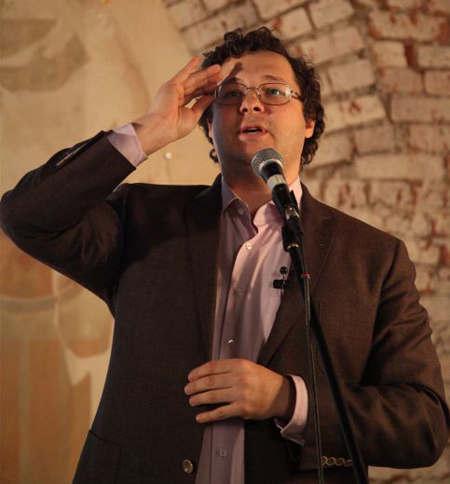
')
- How do you feel about the idea of building a base on the moon?
- In short, it is necessary to build a radio observatory on the Moon, but going to the Moon only for the sake of it is not serious - too expensive. However, if a strategic decision is made that Russia is building a lunar base, I will say: not to place a long-wave radio telescope on the moon is a crime. The ultra-long wavelength range is the only window of the electromagnetic spectrum, which is still not open. Superlong waves from space to Earth do not pass, they are reflected from the ionosphere, respectively, it is necessary to put a telescope outside the Earth. You can put free flyer on the satellite, you can put on the moon. In principle, the moon will be more expensive. On the other hand, if there is already a base there, then it is possible and necessary to install a telescope that will work for a very long time.
- Why not put on satellites?
- You can put on satellites, but you understand that we are talking about large sizes and a large number of radiation receivers. The wavelength is about twenty meters. And how long will that satellite live? At the same time, the telescope on the moon does not even need special maintenance. Just “scatter” the wire over the surface. Why the moon? The problem is not only to put on the satellite, but that we need to protect ourselves from the interference of the Earth - it is very hot in this range.
- So you need to build on the back side?
- Yes, the Moon is considered here as protection of the superlong-wave radio telescope from the radiation of the Earth. It should be placed either on the reverse side or in the craters at the poles. Naturally, there will be a task to transfer data to Earth. If you put on the back of the moon, you need a repeater, and most likely it will be a satellite. If you put on the poles, you can put a repeater on the edge of the crater. Options are discussed, including the implementation of a telescope on a satellite flying around the moon. Then part of the time the telescope is closed by the Moon from the Earth and makes observations. And, accordingly, when opened, resets the data to Earth.
So far this is being discussed at the level of ideas that need to be thought out and worked through. This is the last remaining undiscovered window of the electromagnetic spectrum in the study of the Universe.
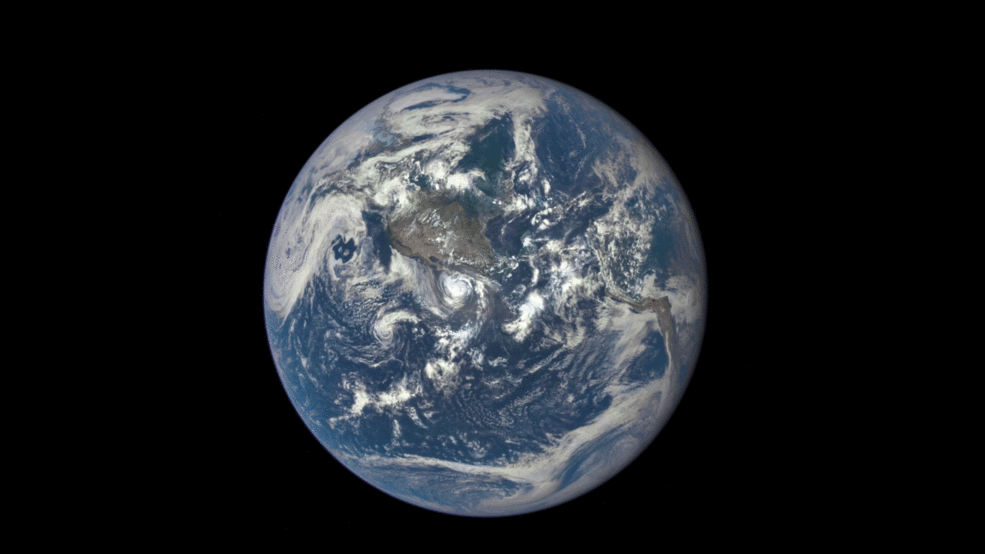
A few words about possible scientific problems. Let's start with the study of the so-called epoch of secondary ionization. This is another potential Nobel Prize, due to which the long-wave radio astronomy in recent years has received a strong impetus to the development and interest of the world community. The study of hydrogen radiation from different cosmological distances in the Universe allows us to construct a three-dimensional map of the Universe in the line of neutral hydrogen. The farther away the hydrogen is, the longer the wave, respectively. In terms of cosmology, this is comparable to relic radiation.
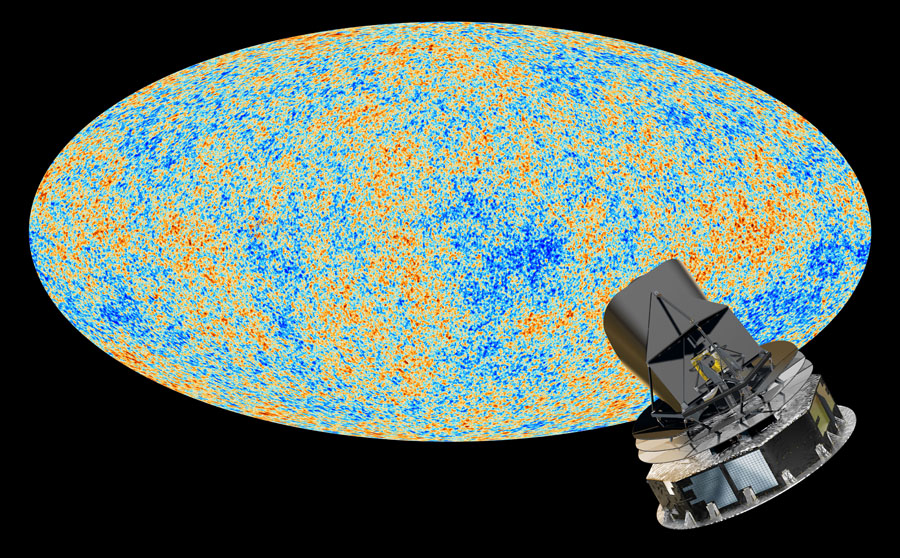
ESA Planck space telescope and its CMB map.
LOFAR, SKA and other projects are studying the epoch of secondary ionization and mapping neutral hydrogen at shorter wavelengths. Under this task, it will also be useful to have an ultra-long-wave radio telescope.
Do not forget that every new window in the electromagnetic spectrum brought its own surprises - results that cannot be predicted in advance. I hope that the last window we are discussing will not be an exception.
- You mentioned the moon satellite. For me, this topic is close. Do you think it is possible to realize at least a prototype of such a telescope on the scale of a microsatellite?
“If your lunar microsatellite can bring out some kind of dipole or a more cunning measuring system, this would be potentially useful. An important question is how much internal interference of the apparatus will interfere with the operation of the telescope. Analysis is required.
- We will think, suddenly what we can do. Thank!
_____________________________________________________
Head of the Space Research Division Joint Institute for VLBI in Europe
Leonid Hurwitz.
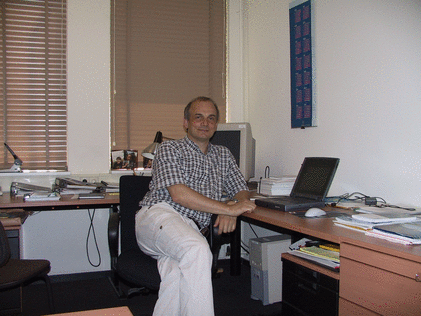
- The equipment necessary for microwave radio astronomy is relatively simple. A radio astronomy receiver for frequencies in this range (frequencies below 10–15 megahertz) can solder a schoolboy radio amateur. It is pretty cheap. And the amount of information, roughly speaking, is proportional to the carrier frequency. The data flow is relatively small, modern digital system will cope. Antenna systems, despite their size - rather large - are very simple. It may simply be wires laid out on the surface.
- And how long should they be?
- Yuri Kovalev has already mentioned: the wavelength is about 20 meters, so the size of the antenna should be no less. At the same time, there are modern technologies that allow the antenna to be made much smaller. For example, cell phones operate at a wavelength of 20 cm, although they do not carry antennas of this size. They have active antennas, and the same technologies can be used in space. But for the lunar surface, it may not be necessary; unwinding it across the surface of the moon or even in outer space, a coil with a very thin wire is not difficult. There is no fundamental difference between the satellite and the surface.
The satellite is more profitable because landing on the surface of the Moon any kind of payload is complex and expensive. The moon has a major advantage - it is protection from man-made interference. A satellite in low orbit around the moon in a certain part of its orbit is shadowed by the moon from the earth, and this can be used. Therefore, the satellite is cheaper than the stationary lunar observatory. On the other hand, since we are flying to explore the moon, this work will require the delivery of tons of cargo, adding to them a few tens of kilograms of payload for radio astronomy is not difficult. And the effect will be enormous. I think in super-long-wave radio astronomy one or two Nobel prizes are hidden. This is practically a law: if some parameter of a research facility improves by an order of magnitude or orders of magnitude, or work begins in a completely new, undeveloped field, then discoveries that are difficult to predict are guaranteed. This fully applies to our topic.
If manned flights to the moon are, and they definitely will, it will be unforgivable not to use this opportunity to deploy a super-long-wave radio telescope there. So in the future lunar program, radio astronomy will be a passing passenger, and in outer space you can create an independent observatory. The scientific motivation is the same, but the advantage of the satellite is that you can create a whole swarm of microsatellites, in which each device carries one antenna element, simple, light. This swarm of satellites can be placed anywhere or in the shadow of the Moon, for example, at the Lagrange-2 point of the Earth-Moon system. This point is located behind the Moon, where satellites will be protected from man-made interference. Placement at this point has several limitations. The point is such an ideal position, in fact, the satellite at this point performs the so-called. “Lissajous figures”, and only at some stages of its movement it turns out to be in the shadow of the Moon.
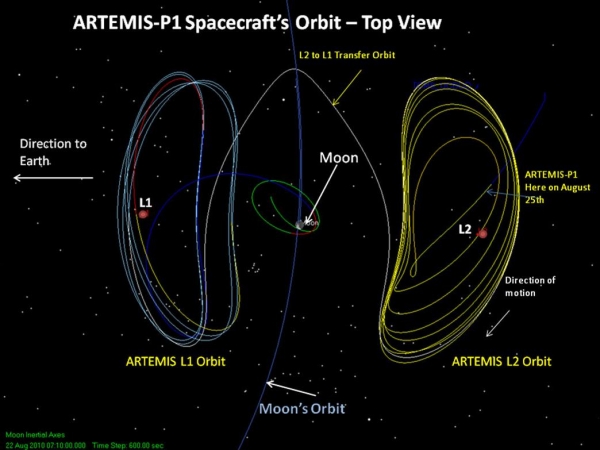
This swarm can also be located in low circumlunar orbit. Then this swarm will spend some part of its orbit in the cone shading the Earth. Such options are being considered, a specific project is being developed in China. You might think about running a superlong-wave observatory somewhere very, very far away. So far that man-made interference from Earth will be negligible due to the distance. But you have to fly pretty far. Remember, in the screensaver of the movie “Contact” the spacecraft flies away from the Earth, and at first there is a lot of interference around it, then it moves further and further, and the signal propagation takes more time. Finally, they intercept the first broadcast from the Berlin Olympics in 1936, then the first radio signals - and silence. So, silence comes due to two factors: first, they flew so far that they almost moved in time, and second, the distance factor affects. The distance is proportional to the square in the denominator. That is, if you retired ten times, then the intensity of the noise decreased a hundred times. Retiring ten times further than the moon, we will reduce the interference a hundred times. Remove a hundred times - reduce the interference in ten thousand.
Accordingly, we have three ways: on the surface of the back side of the Moon, on the near-moon satellite, or very far away. There is no departure option at all in real development. And there is an option on the moon and on the moon near the moon. This is done by the Chinese colleagues in the Chang'e program. In Russia, the lunar program is also being revived, there are projects “Luna-25”, -26, -27, -28 ... Unfortunately, so far none of these devices have a payload for super-long-wave radio astronomy. This is unfortunate, since it would allow “cutting off the corner” in the race for discoveries in this range. By technology and cost it is relatively easy. It is much, much cheaper to build such a super-long-wave radio telescope than “Radioastron” or others from the “Spectrum” series. The payload is simple, cheap, but guaranteed to bring significant discoveries.
If we talk about a test satellite that would be suitable for our purposes, then a device with a mass of several kilograms would suffice. We designed an antenna that is suitable for our purposes, which is not a dipole, but a tripol. This is a symbiosis of a conventional dipole and an active antenna with an amplifier, an analog-digital converter, a processing and transmission system that pulled a few kilograms. Dimensions were obtained like a small photo stand. If such a piece is thrown out in a circumlunar orbit, then it is able to function there independently.
Are you aware of the Chinese organization Harbin University of Technology? They are actively working with CNSA on a similar project, and they are trying to insert it into the Chang'e program. In addition, as part of the Chang'e program, antennas are being developed on two Chang'e devices. One antenna on the satellite transponder, and the other at the landing stage, sitting on the reverse side of the moon.
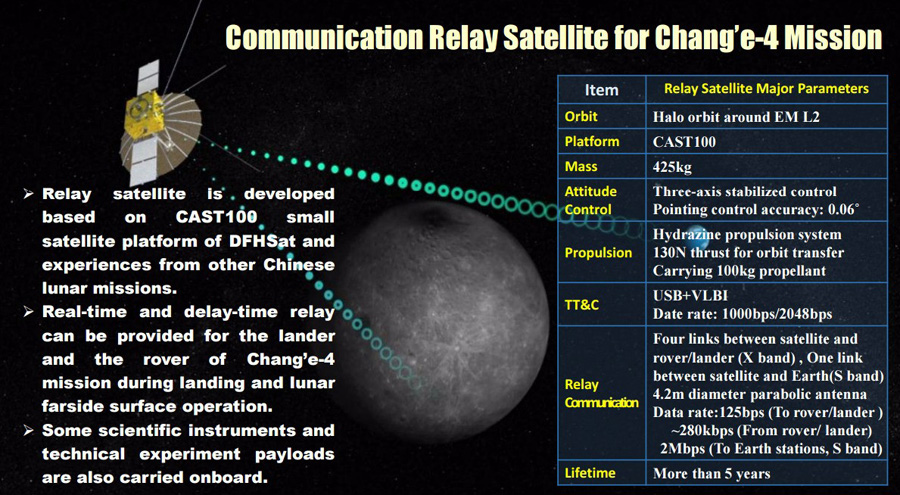
Illustration: chinaspaceflight.com.
The possibility is being considered of placing a superlong wave payload on both vehicles. Then they will have a super-long-range radio interferometer, similar to RadioAstron, only in the superlong wavelength range. China is going to have a repeater just at the Lagrange point-2 of the Earth-Moon system with known advantages and disadvantages of this point, which we have already mentioned. This work is already underway.
I thank you for your help in preparing the material for the head of the laboratory of physics of magnetospheric processes at the Space Research Institute of the Russian Academy of Sciences Mikhail Mogilevsky .
Source: https://habr.com/ru/post/401901/
All Articles